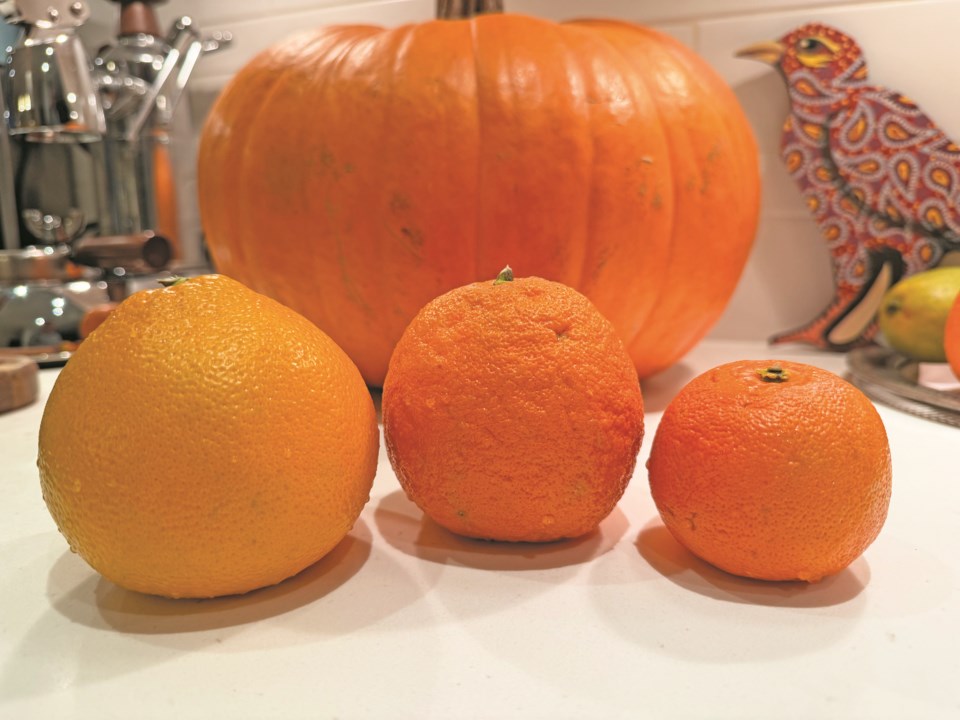From Pemby to Squamish, you’d be hard-pressed to find a fridge anywhere in the Sea to Sky without a jar of m-m-m-marvellous marmalade on the shelves.
Sue and Bob Adams; Bob Barnett; even “Grateful Greg” Reamsbottom, crucial half of The Hairfarmers—the perennially favourite band that delivers Whistler’s soundtrack: All have marmalade of one type or other on their shelves. Good chance Greg’s will be homemade.
Marmalade is a centuries-old, cross-cultural delight. The word “marmalade” originally referred to quince jam and came from the Portuguese word for quinces, marmelo. There’s ginger marmalade, tomato marmalade, kumquat marmalade and, yes, even Portuguese quince marmelada, but most of us think “orange” when it comes to marmalade. (The word “orange” actually comes from the Sanskrit, naranga.)
But when I think marmalade, I think Seville orange, also known as the sour orange or bitter orange. It originated in southern Vietnam, and was imported into Spain and Portugal in the 12th century. There it quickly displaced quince as the main ingredient in marmalade.
All marmalades are really quite marvellous in their intensity and density, and it’s so easy to whip up a marvel of your own. The joy of sugar preserves, as a true marmalade is, is that you rely on the natural reaction between the sugar, the fruit acids and the fruit’s own pectin. Try the recipe below hubbie invented. The result is so delicious you won’t be able to keep your hand out of the pot.
I did a much simpler little experiment using three different Seville oranges. All were grown in California and I wanted to taste each. Boy, were they different! The smaller, darker one (see above) was the tastiest, with loads of that punchy bitter pow of a classic Seville orange. The largest one was good—full of seeds like any Seville orange—but the fruit’s flavour was much closer to a regular orange. The peel, however, was pure Seville.
I thinly sliced about a cup of peel with the white pith intact, squeezed the juice from the segments, and put it all, uncovered, into a small, heavy saucepan with enough regular orange juice to barely cover it and three tablespoons of sugar. You might want more, but I like it zingy. That’s it. No pectin needed, there’s enough in the peel to thicken it.
Be playful! Slowly simmer it for about 20 minutes, adding more OJ or sugar as you like. It thickens as it cools, so I quit when mine was thinner than marmalade, more like a cranberry sauce. Great with yogurt, toast and roast chicken.
Whip it up with your kids home on spring break, then make your own marmalade sandwiches to keep under your hats for emergencies, like Paddington bear does.
Easter is springing up soon, and if you’re planning on ham you couldn’t find a tastier glaze than this marmalade-y one, below, compliments of one of my oldest pals, Dianne Faux. She once ran the women’s shelter in Squamish, a branch of which is soon coming to Whistler.
You can also find some very good commercial marmalades, Seville orange and otherwise. The original Dundee-style marmalade of Scotland goes back to 1797 and, you guessed it, Dundee, Scotland, where it was produced by one James Keiller, whose mother made a batch of jam from Seville oranges a little worse for the wear after the importing ship navigated a raging storm. See? Imperfect produce can have excellent outcomes.
London Drugs offers good Scottish brands, like Mackays, a relative newcomer, started in 1938, and Robertson’s, which harkens back to 1864 and is an official supplier to the royal household.
But if you want an outstanding local one, try Vancouver-based Le Meadow’s Pantry. Owner Genevieve Blanchet cooks her marmalades in small batches in traditional copper pots, offering three varieties, including a U.K. award-winning one. But it’s her Seville orange marmalade that’s my favourite—only two ingredients, pure cane sugar and Seville oranges. No pectin added, as it should be.
Peter’s Seville orange marmalade
Wash and halve 1 pound of Seville oranges. Squeeze the juice into a medium-sized bowl. Toss the seeds. Scrape the membranes from the peels and put them in a cheesecloth bag (a piece of clean pantyhose will do); tie it up. Finely shred about a third of the peels and mince the rest. Add them to the juice, along with the bag of membranes and about 1.25 pints of water. Cover the bowl and refrigerate overnight. The next day dump the whole lot into a pot. Add another 1.25 pints of cold water. Bring it slowly to a boil. Simmer gently, stirring often, until the peels are tender, about 20 minutes. Measure the volume of the mixture, and add 2 cups sugar, preferably raw organic with its fuller flavour, for every cup of mixture. Bring it back to a rolling boil. Cook about 15 minutes, stirring constantly. When it’s done to your liking, remove the old bag, and pour your marmalade into sterilized jars.
Dianne’s marvellous ham glaze
Heat together in a pot: 2 cups orange juice, 1/2 c. maple syrup, 1/4 c. marmalade, 2 tbsp. Dijon mustard. Bring to a boil, simmer for 5 minutes until well blended. Use a 5- to 6-pound cooked ham shank, bone-in. Remove the skin and score the fat in a diamond design and stud with cloves, for a classic touch and flavour. Place on a wire rack in a roasting pan lined with foil, which makes it easy to clean. Bake 2-3 hours at 325 F, pouring 1/4 cup of glaze over ham every 1/2 hr. or so. You can also cover the ham with foil or a lid if things start getting too brown. Yum!
Glenda Bartosh is an award-winning journalist who plays more in the kitchen the older she gets.




